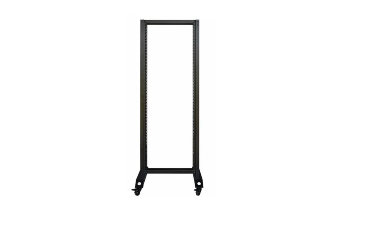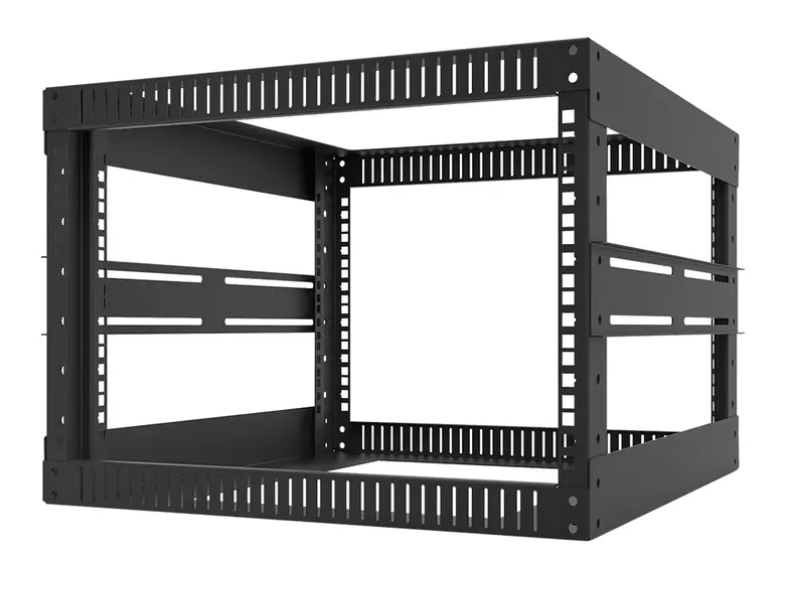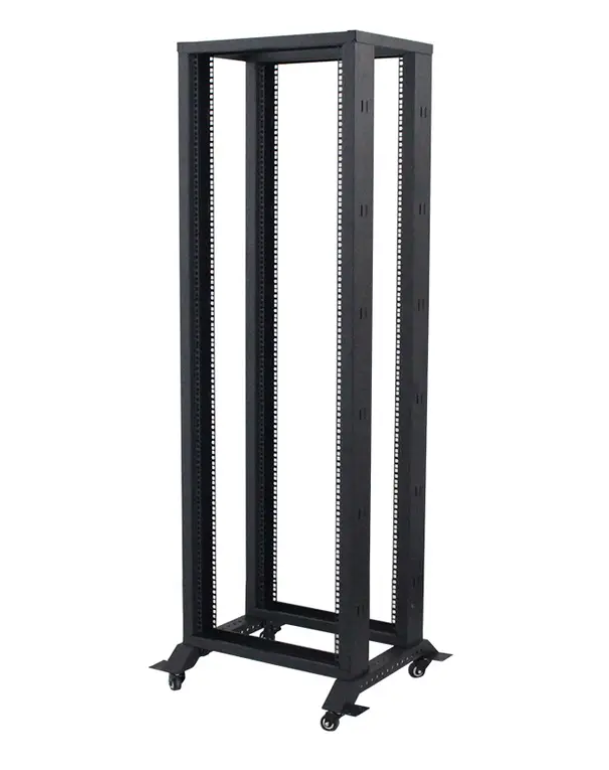
Open server racks are a popular choice for data centers, offering easy access and improved airflow. But choosing the right size is crucial for efficiency. The wrong size can disrupt airflow, waste space, and affect equipment performance. In this post, we'll explore the different sizes of open server racks and how to choose the perfect one for your setup.
What Are Open Server Rack Sizes and Why Do They Matter?
Open server rack sizes are defined by three key dimensions: height, depth, and width. The height, measured in rack units (U), indicates how much equipment can fit. Depth refers to the front-to-back space for equipment and cable management, while width typically follows the 19-inch standard. Rack size directly impacts performance by affecting equipment density, cooling efficiency, and maintenance access. A well-chosen rack ensures optimal airflow, prevents overheating, and simplifies maintenance, making it crucial for efficient server operation.

Open Server Rack Sizes: Key Dimensions and Their Impact
Understanding Rack Units (U) – How to Measure Open Server Rack Sizes
What Are Rack Units (U)?
Rack units (U) are the standard way to measure the height of server racks. Each U unit equals 1.75 inches. Common sizes include 1U, 2U, 3U, and 4U, each designed to fit different types of equipment. A 1U rack is ideal for compact devices like network switches, while 2U, 3U, or 4U racks are suitable for larger, high-performance servers.
How Does Rack Unit Size Affect Equipment Placement?
Choosing the correct rack height is critical to ensure your equipment fits properly and functions efficiently. Smaller devices require fewer U units, whereas larger devices may need more space. The number of U units in a rack directly impacts server placement, making it essential for airflow and cooling. A rack that's too crowded may restrict airflow, causing overheating and maintenance difficulties.
The Importance of Rack Depth
How Does Depth Affect Equipment Fit and Cooling?
Rack depth plays a significant role in accommodating larger servers and maintaining proper cooling. Shallow racks (e.g., 24 inches) are suitable for smaller devices, such as network switches and routers. Deeper racks (e.g., 48 inches) offer more space for high-density setups, helping to manage cables and provide room for airflow to cool the equipment.
What Depths Are Available for Open Server Racks?
Common depths include 24 inches, 36 inches, and 48 inches. If your equipment requires extra space for cooling or cable management, deeper racks are the better option. A deeper rack also allows you to fit larger servers, reducing the risk of cramped, overheating setups. Additionally, deeper racks can provide better airflow, which is crucial for maintaining optimal equipment performance.
Open Server Rack Width and Its Role
What Is the Standard Width for Open Server Racks?
The standard width for open server racks is 19 inches, which is compatible with most IT equipment, including servers, storage devices, and network switches. However, some environments may require wider racks, such as 24 inches, to provide more room for cables, power distribution units (PDUs), and other components.
How Does Rack Width Affect Cable Management?
Wider racks offer significant advantages when it comes to organizing cables. More space means better cable management, which reduces the risk of cables blocking airflow. A wider rack allows you to mount PDUs and other essential components more easily, improving organization and maintaining system efficiency. Good cable management not only improves airflow but also makes maintenance more straightforward by preventing tangled or obstructed cables.
Different Types of Open Server Racks and How They Vary in Size
2-Post Open Server Racks
What Are 2-Post Open Server Racks?
2-post racks are simple and cost-effective solutions designed for lighter equipment. They are commonly used for network switches, patch panels, and other small devices. These racks typically have a height range of 12U to 45U and come with depths of 24 inches or 29 inches.
Advantages and Limitations of 2-Post Racks
2-post racks are lightweight and affordable, making them ideal for smaller setups. However, their ability to support larger or heavier equipment is limited. They are better suited for lighter devices, and their design offers less stability compared to 4-post racks. This makes them less ideal for high-performance or high-density configurations.
4-Post Open Server Racks
What Are 4-Post Open Server Racks?
4-post racks are more robust, designed for heavier and larger equipment like servers, storage devices, and more complex systems. These racks provide better stability and are capable of supporting larger configurations, allowing for deeper racks that accommodate more equipment.
How Do 4-Post Racks Support Heavier Loads?
The four vertical posts in 4-post racks offer significant stability. They provide extra support, making them perfect for equipment that needs more durability. With these racks, you can mount heavier servers or storage systems without worrying about compromising the structure or performance.

Open Server Rack Sizes for Different Use Cases
Choosing the Right Rack Size for Small Business or Home Office
What Size Rack Is Ideal for Smaller Setups?
For smaller environments, such as home offices or small businesses, racks with sizes ranging from 6U, 12U, or 24U are often sufficient. These sizes are ideal for housing network equipment, a few servers, and other necessary components like routers or switches. A 6U rack can hold essential network gear, while 12U and 24U racks provide space for more equipment without taking up too much floor space.
What Are the Benefits of Smaller Racks?
Compact racks are not only cost-effective but also save space, making them perfect for smaller setups where space is limited. Their smaller footprint means they fit into tighter spaces and still provide efficient storage. Additionally, these racks are generally easier to install and maintain, and they ensure that smaller environments don't waste valuable space while still offering enough room to grow.
Open Server Rack Sizes for Larger Data Centers
What Size Rack Is Best for Large-Scale Data Centers?
Larger data centers require bigger racks like 42U and 48U, which offer ample space for high-density configurations. These sizes are commonly used because they allow for more servers and devices to be housed in a single rack, streamlining your data center's design. 42U racks are a popular choice for general data center use, while 48U racks are better suited for environments requiring more space for additional components.
Why Are Larger Racks Necessary for High-Density Setups?
Larger racks accommodate more equipment, which improves space utilization and helps keep the data center organized. This is crucial for maintaining a high-density environment, where maximizing every inch of space is essential. Larger racks allow for scalability, ensuring that as your equipment grows, you don't need to invest in new racks. They also provide room for better cable management, airflow, and cooling, which are all critical for performance and efficiency.
How to Choose the Right Open Server Rack Size for Your Needs
What Factors Should You Consider When Choosing a Rack Size?
When selecting a server rack, several factors play a crucial role in determining the ideal size:
● Equipment Type: The type of equipment you plan to house is a key factor. Smaller devices like switches or routers may only need a 6U or 12U rack. Larger servers and storage devices will require 42U or 48U racks for adequate space.
● Space Utilization: You need to consider the available space in your environment. A larger rack might seem beneficial, but if you have limited room, it could cause clutter. Smaller racks are ideal for tighter spaces but may lack scalability.
● Cooling Requirements: The size of the rack affects airflow. Larger racks provide more space for cooling solutions, while smaller racks may restrict airflow, leading to overheating. Ensure your rack size accommodates sufficient airflow for optimal performance.
● Future Growth: Think ahead. Choosing a rack with some extra space allows you to add more equipment in the future without needing to upgrade your rack size. You don't want to outgrow your rack too quickly.
What Are the Trade-offs Between Choosing a Larger or Smaller Rack?
Larger racks give you more capacity, making them ideal for high-density setups and future expansion. However, they can waste space and increase costs if your equipment doesn't fill the rack. They may also consume more energy for cooling.
Smaller racks are more cost-effective and save space. They're perfect for setups with limited equipment but might not provide enough room for future growth. Over time, they could require an upgrade if your needs expand, and they may face challenges with airflow and cooling.
Conclusion
To finalize your open server rack size decision, balance your current needs with future growth. Choose a size that maximizes space efficiency, supports cooling requirements, and allows for scalability. This ensures your setup remains efficient and adaptable as your equipment needs evolve.
WebiT has years of experience in in designing and manufacturing customized Open Frame Server Racks. If you want to know more about Open Frame Server Racks, feel free to contact us anytime with your inguiries.
FAQ
Q: What is an open server rack?
A: An open server rack is a frame used to store and organize servers and other IT equipment without enclosed sides. It provides easy access, improved airflow, and better cable management.
Q: What is the standard width of a server rack?
A: The standard width of a server rack is 19 inches. This width accommodates most rack-mounted IT equipment like servers, switches, and routers.
Q: How do I determine the size of my server rack?
A: The size of your server rack is determined by its height (measured in U units), depth, and width. Consider your equipment type, cooling needs, and available space when choosing the size.
Q: What are the most common rack sizes for data centers?
A: The most common rack sizes for data centers are 42U and 48U. These provide ample space for high-density setups and future growth.
Q: Why should I consider the depth of a server rack?
A: Rack depth affects equipment fit and cooling. Shallow racks are suitable for smaller devices, while deeper racks support larger servers and better airflow.


















